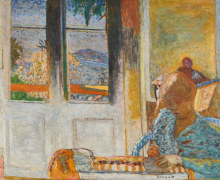Known for his radiant paintings with elaborately patterned surfaces and innovative formal compositions, Pierre Bonnard (1867-1947) was committed to the exploration of color, figuration, and decorative pattern in his work. Painting predominantly still lifes, landscapes, and intimate scenes of his longtime muse—his wife, Marthe de Méligny—Bonnard transformed traditional art historical subjects and images of his everyday world into bold experiments in color, pattern, and composition. He ranks among the great colorists of art history, described by Henri Matisse as “a great artist for our time and, naturally, for posterity.”
Bonnard was born in 1867 in Fontenay-aux-Rose, a suburb of Paris. He studied painting while earning his law degree at the Sorbonne, attending art classes at the École des Beaux-Arts before enrolling at the Académie Julian in 1889, where he met Paul Sérusier, Maurice Denis, Edouard Vuillard, Félix Vallotton, and other young artists who would join together to form the Symbolist group known as Les Nabis (named for the Hebrew word for “prophets” or “seers”). After briefly practicing as a barrister, Bonnard devoted himself to painting, sharing a studio in Montmartre with Denis and Vuillard.
Looking to transform and revitalize painting, the Nabi painters were committed to creating work that was more than just a representation of the natural world, but synthesized symbolic and spiritual metaphors in its imagery. Stylistically, they strove to achieve a purely decorative quality in their paintings, inspired by the pure colors and simplified, flattened forms of Paul Gauguin and the bold compositions of Japanese prints. Though he embraced the flattened, decorative aesthetic of the Nabi movement, Bonnard was fascinated by simple scenes of daily life rather than representing metaphorical or mystic subjects—in addition to landscapes, café scenes, and intimate, colorful still lifes, like Vuillard, he began to paint decorative interiors whose inhabitants are almost completely embedded into the patterns of their surroundings. True to the Nabi goal of breaking down the distinction between art and decoration, Bonnard also designed textiles, painted screens, stained glass, stage sets, and advertisements at this time.
By the beginning of the twentieth century, the Nabis had disbanded. By 1910, Bonnard had left Paris for the south of France, and soon he began to experiment with the pictorial structures of his compositions and adopted a brilliant, sun-drenched palette. Despite the developments of his contemporaries—such as Fauvism, Cubism, and Surrealism—Bonnard continued to seemingly look largely to Impressionism for inspiration, painting fleeting moments of the everyday world in loose, painterly brushwork. While his work features the quick brushstrokes of Impressionism, Bonnard’s bold experiments with color and composition differentiated his work from his forbears. He used color to build forms in his canvases, elevating it from a decorative element to an essential component. Bonnard believed that “color does not add a pleasant quality to design- it reinforces it.” Rarely working from life or en plein air, Bonnard produced preliminary sketches, watercolors, and sometimes photographs as studies for the majority of his paintings, which he would then annotate with notes about color. He strove not to replicate an exact moment, but to capture a nostalgic memory of a lived experience.
Fascinated by different levels of perspective and perception, Bonnard also experimented with unexpected formal innovations in his paintings, often organizing his paintings around strong vertical or horizontal partitions, such as walls, doors, or windows. Drawing the viewer’s eye to both the intimate world indoors and the expanse of the outdoors through diagonals and complex spatial compositions, he also liked to hide subjects at the edges of his paintings, being fascinated by how the eye perceives peripheral objects. He wanted his viewers to actively scan the surface of his paintings in order to discover hidden images and details, animating certain objects with detail and focus, deliberating leaving other surfaces and forms out of focus.
In 1927, Bonnard acquired a villa in the village of Le Cannet near Cannes in the south of France, where he would live for the rest of his life. Continuing to paint the familiar world around him, he painted seascapes, views of his garden at Le Cannet, and still-lifes. He also embarked on a remarkable series of sunlit interior scenes, creating immersive, luminous worlds of decorative pattern and color, which frequently feature the lithe, sensuous form of Marthe. Sitting at the table or in her private bath, she is so immersed in her surrounding, intimate world, that she is often almost entirely camouflaged by the patterns and color around her. Often painting Marthe in very private, intimate moments, such as bathing, powdering, or dressing, Bonnard represented Marthe’s nude, slender body as ageless; even in his last paintings of her she appears unchanged from his first studies. In Bonnard’s compositions, Marthe is self-absorbed in her activities, seemingly unaware of the viewer, her introspection endowing the paintings with a sense of intimacy, languor, and timeless tranquility. Marthe died in January of 1942, but Bonnard continued to paint landscapes, still lifes, and images of his wife from memory at his home in Le Cannet until his death on January 23, 1947.

